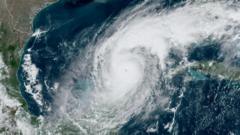The National Oceanic and Atmospheric Administration (NOAA) is predicting a particularly busy hurricane season for the Atlantic, Caribbean, and Gulf of Mexico from June to November, with forecasts indicating 13 to 19 named tropical storms. This alarming outlook comes amid significant staffing cuts to the agency, leading to concerns over the effectiveness of tracking and predicting destructive storms.
Forecasters estimate that out of the projected storms, six to ten may develop into hurricanes, with three to five possibly reaching major hurricane status (Category 3 or above). While these numbers are lower than the preceding year’s season, which saw 18 total storms including 11 hurricanes, they exceed the long-term average. Current conditions such as warmer-than-normal sea surface temperatures and the likely absence of El Niño (which typically inhibits hurricane formation) are identified as key contributors to this increased outlook.
Scientists warn that these projections are overshadowed by the ramifications of staffing reductions within NOAA following the Trump administration's spending cut initiatives. Significant layoffs have led to a shortage of personnel within key offices, particularly those responsible for intensive hurricane monitoring and forecasting, which raises concerns about overall data collection and forecast precision.
Experts within the meteorological community express growing apprehension over how these cuts—and reduced resources—may hinder timely and effective hurricane preparedness. Critical positions within National Weather Service branches remain unfilled, and the inability to hire new staff exacerbates the situation, as crucial operational capacity is strained. Limited personnel could lead to burnout amongst remaining staff, jeopardizing the ability to issue timely warnings as storms approach the coast.
"We need to maintain a robust system of observation and data collection," explains Daniel Swain, a climate scientist at UCLA. "Cuts in this area not only endanger local forecasts but could have cascading effects globally."
Despite NOAA's ongoing commitment to advancing forecasting capabilities, the impacts of these cuts are significant and could affect public safety as intense storms remain a persistent threat. Experts emphasize that every reduction in observational data, whether through less frequent weather balloon launches or diminished "hurricane hunter" flight missions, increases the risk of less accurate forecasts, potentially leading to dire consequences during severe weather events.
As the hurricane season approaches, the collaboration between scientists, meteorologists, and the public aimed at maximizing safety and readiness faces an uphill battle, underscoring the urgent need for increased investment in NOAA's workforce and resources. The stakes could not be higher, with community safety reliant on the ability to accurately predict and respond to these formidable storms.





















